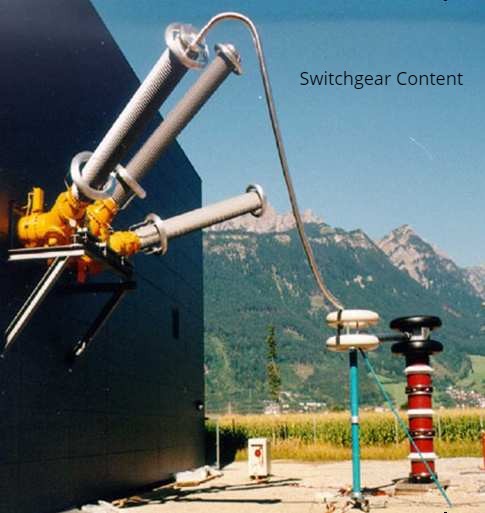
The final assembly of the gas insulated substation is then completed in the field, where all the various components that comprise a GIS meet for the first time. Even if the gas insulated.substation could be completely assembled in one factory, it would still need to be disassembled for shipment, shipped, and then reassembled at the job site.
The purpose of the field tests is to verify that all the GIS components perform satisfactorily, both electrically and mechanically, after assembly at the job site. The tests provide a method of demonstrating that the GIS apparatus has been assembled and wired correctly and will perform satisfactorily.
1- Mechanical tests: Gas Leakage and Gas Quality (Moisture, Purity, and Density):
All gas compartments shall be filled with sulfur hexafluoride gas (SF6) or a required gas mixture to the manufacturer’s required rated filling pressure and tested to detect any gas leaks.An initial test is performed to detect any and all gas leaks and ensure compliance with the specified maximum gas leak rate. These gas leak tests need to include all enclosure flanges, welds of enclosures, and all gas monitoring devices, gas valves, and interconnecting gas piping that have been assembled at the job site.
The moisture content of the gas shall be measured prior to energization. In order to get a reliable measurement, the moisture content shall be measured some time after filling as recommended by the manufacturer. The moisture content shall not exceed the limit prescribed by the manufacturer or as agreed to between the manufacturer and user, whichever value is lower.
The purity of the gas, as a percentage of SF6, shall be verified prior to energization. The gas purity shall meet the requirements prescribed by the manufacturer.
The density of the gas shall be measured and verified to be in accordance with the manufacturer’s nominal rated filling requirements.
2-Electrical Tests: Contact Resistance:
Contact resistance measurements of the main current carrying circuits need to be performed on each bus connecting joint, circuit breaker, disconnect switch, grounding switch, bushing, and power cable connection to demonstrate and verify that the resistance values are within specified requirements.Contact resistance measurements also need to be made on the GIS enclosure bonding connections, in cases where an isolated (single) phase bus is being used.
The resistivity measurements shall not exceed the maximum values permissible limits according to IEEE Std C37.100.1.

3-Electrical Tests: low frequency AC voltage withstand test:
The gaseous and solid insulation (dielectrics) of the GIS shall be subjected to a low frequency (30 Hz to 200 Hz) conditioning voltage application at voltage levels and durations specified by the manufacturer. The conditioning voltage application shall be followed by a one minute low frequency (30 Hz to 200 Hz).
This one-minute low frequency voltage withstand test is performed at 80% of the rated low frequency withstand voltage performed in the manufacturer’s factory.The purpose of these high voltage tests is to verify that the components of the gas insulated substation have survived shipment, have been assembled correctly, that no extraneous material has been left inside the enclosures, and that the GIS can withstand the test voltage.

4-Electrical Tests: AC Voltage Withstand Requirements and Conditions:
Voltage withstand tests need to be made between each energized phase and the grounded enclosure. For enclosures containing all three phases, each phase needs to be tested, one at a time, with the enclosure and the other two phases grounded. Before voltage withstand tests are initiated, all power transformers, surge arresters, protective gaps, power cables, overhead transmission lines, and voltage transformers need to be disconnected. Voltage transformers may be tested up to the saturation voltage of the transformer at the frequency of the test.
5-Electrical tests: low frequency ac voltage withstand requirements and conditions:
Voltage withstand tests shall be made between each energized phase and the grounded enclosure. For enclosures containing all three phases, each phase shall be tested, one at a time, with the enclosure and the other two phases grounded. The insulation between each two phase conductors are not required to be subjected to any other field voltage withstand tests.
Before voltage withstand tests are initiated, all power transformers, surge arresters, protective gaps, power cables, and overhead transmission lines shall be disconnected. Voltage transformers shall be tested up to the saturation voltage of the transformer at the frequency of the test.
Isolating sections of the GIS apparatus may give an additional benefit of field testing the open gap of some disconnecting switches, although such a field test is not a requirement. In addition, it may be necessary to isolate sections of the GIS to facilitate location of a disruptive discharge or to limit the energy potentially discharged during a disruptive discharge.
A measurement of partial discharges may be performed to detect possible intrusion of conductive particles or damage to high-voltage insulating components occurring during factory testing, transportation, or installation. The gas-insulated switchgear shall be essentially free of partial discharge. The procedure for partial measurement and interpretations shall be provided by manufacturer and agreed between user and manufacturer.
6-Electrical Tests: DC Voltage Withstand Tests:
DC voltage withstand testing is not recommended on a completed GIS. However, it may be necessary to perform a DC voltage withstand test on power cables connected to a GIS. these test voltages would, by necessity, be applied from the end of the cable opposite to that of the GIS, therefore subjecting a small portion of the GIS to the DC voltage. It is recommended that the portion of the GIS subjected to this DC voltage be kept as small as possible. The manufacturer should be consulted before performing these tests.
7-Electrical tests: tests on auxiliary circuits:
Dielectric, continuity, and resistivity tests shall be performed on all interconnecting control wiring installed in the field.
8-Mechanical and Electrical Functional and Operational Tests:
The following need to be verified after assembly of the GIS at the job site:
- The torque value of all bolts and connections assembled in the field need to be verified to be in accordance with the specified requirements.
- The conformity of the control wiring needs to be verified to be in accordance with the schematic and wiring diagrams.
- The proper function of each electrical, pneumatic, hydraulic, mechanical, key, or combination of interlock methods needs to be verified for correct operation in both the permissive and blocking condition.
- The proper function of the controls, gas, pneumatic, and hydraulic monitoring and alarming systems, protective and regulating equipment, operation counters, including heaters and lights, needs to be verified.
- Each mechanical and electrical position indicator for each circuit breaker, disconnect switch, and grounding switch needs to be verified that it correctly indicates the device’s position, both open and closed.
- The conformity of the gas zones, gas zone identification, gas valves, gas valve positions, and interconnecting piping needs to be verified to be in accordance with the physical drawings.
- The operating parameters, such as contact alignment, contact travel, velocity, opening time, and closing time of each circuit breaker, disconnect switch, and grounding switch need to be verified in accordance with the specified requirements.
- The correct operation of compressors, pumps, auxiliary contacts, and anti-pump schemes needs to be verified to be in conformance with the specified requirements.
- The circuit breakers need to be trip-tested at minimum and maximum control voltages to verify correct operation.
- The secondary wiring needs to be verified to have correct wire lugs, correct crimping, tightened terminal block screws, correct wire and cable markers, and correct wiring in accordance with the manufacturer’s drawings.
Connecting the GIS to the Electrical System:
Once the gas insulated substation has been completely installed, wired, and all field testing has been completed satisfactorily, the new apparatus is ready to be connected to the existing electrical system. This effort involves another series of testing to verify protective relay operation, ability of the circuit breakers to trip on command from remote locations, and proper phase relationships with various transmission lines. This second series of tests is expected to be similar, if not exactly the same, as the tests performed on an AIS substation.
References:
- IEC 6227-1 (2011) High-Voltage switchgear and Controlgear – Part 1: Common Specifications.
- IEEE C37.122 (2010) IEEE Standard for Gas-Insulated Substations.
- IEEE C37.122-1 (2013) Guide for Gas Insulated Substations Rated Above 52 kV.
- Gas Insulated Substations Book Edited by Hermann Koch.
- https://www.omicronenergy.com
- High-voltage Tests and Measurements during the Life Cycle of GIS Article Authors: U.Schichler,E. Kynast
- On site tests of GIS S.M. Neuhold FKH Fachkommission für Hochspannungsfragen Zürich, Schweiz.



